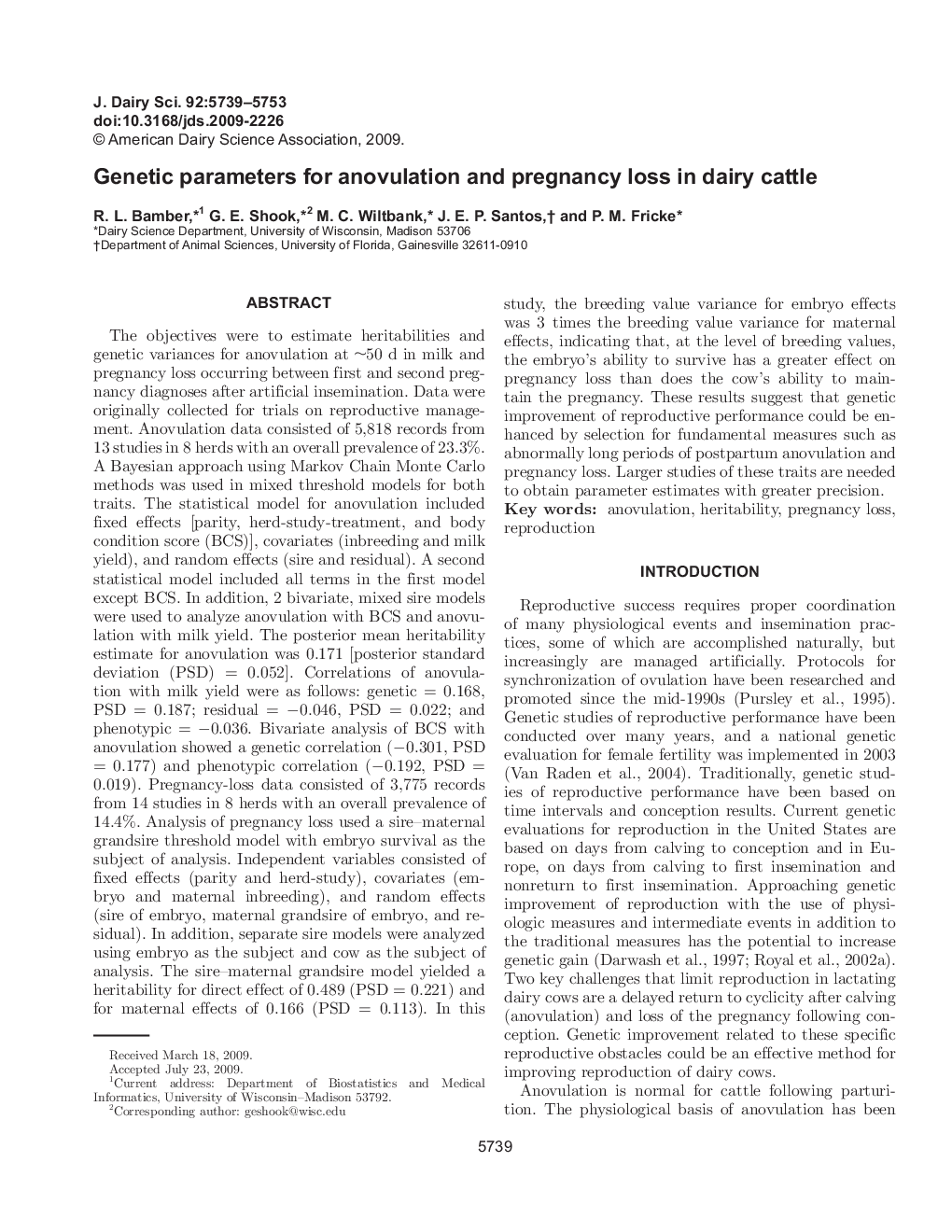| کد مقاله | کد نشریه | سال انتشار | مقاله انگلیسی | نسخه تمام متن |
|---|---|---|---|---|
| 2439137 | 1108087 | 2009 | 15 صفحه PDF | دانلود رایگان |
عنوان انگلیسی مقاله ISI
Genetic parameters for anovulation and pregnancy loss in dairy cattle
دانلود مقاله + سفارش ترجمه
دانلود مقاله ISI انگلیسی
رایگان برای ایرانیان
کلمات کلیدی
موضوعات مرتبط
علوم زیستی و بیوفناوری
علوم کشاورزی و بیولوژیک
علوم دامی و جانورشناسی
پیش نمایش صفحه اول مقاله

چکیده انگلیسی
The objectives were to estimate heritabilities and genetic variances for anovulation at â¼50 d in milk and pregnancy loss occurring between first and second pregnancy diagnoses after artificial insemination. Data were originally collected for trials on reproductive management. Anovulation data consisted of 5,818 records from 13 studies in 8 herds with an overall prevalence of 23.3%. A Bayesian approach using Markov Chain Monte Carlo methods was used in mixed threshold models for both traits. The statistical model for anovulation included fixed effects [parity, herd-study-treatment, and body condition score (BCS)], covariates (inbreeding and milk yield), and random effects (sire and residual). A second statistical model included all terms in the first model except BCS. In addition, 2 bivariate, mixed sire models were used to analyze anovulation with BCS and anovulation with milk yield. The posterior mean heritability estimate for anovulation was 0.171 [posterior standard deviation (PSD) = 0.052]. Correlations of anovulation with milk yield were as follows: genetic = 0.168, PSD = 0.187; residual = â0.046, PSD = 0.022; and phenotypic = â0.036. Bivariate analysis of BCS with anovulation showed a genetic correlation (â0.301, PSD = 0.177) and phenotypic correlation (â0.192, PSD = 0.019). Pregnancy-loss data consisted of 3,775 records from 14 studies in 8 herds with an overall prevalence of 14.4%. Analysis of pregnancy loss used a sire-maternal grandsire threshold model with embryo survival as the subject of analysis. Independent variables consisted of fixed effects (parity and herd-study), covariates (embryo and maternal inbreeding), and random effects (sire of embryo, maternal grandsire of embryo, and residual). In addition, separate sire models were analyzed using embryo as the subject and cow as the subject of analysis. The sire-maternal grandsire model yielded a heritability for direct effect of 0.489 (PSD = 0.221) and for maternal effects of 0.166 (PSD = 0.113). In this study, the breeding value variance for embryo effects was 3 times the breeding value variance for maternal effects, indicating that, at the level of breeding values, the embryo's ability to survive has a greater effect on pregnancy loss than does the cow's ability to maintain the pregnancy. These results suggest that genetic improvement of reproductive performance could be enhanced by selection for fundamental measures such as abnormally long periods of postpartum anovulation and pregnancy loss. Larger studies of these traits are needed to obtain parameter estimates with greater precision.
ناشر
Database: Elsevier - ScienceDirect (ساینس دایرکت)
Journal: Journal of Dairy Science - Volume 92, Issue 11, November 2009, Pages 5739-5753
Journal: Journal of Dairy Science - Volume 92, Issue 11, November 2009, Pages 5739-5753
نویسندگان
R.L. Bamber, G.E. Shook, M.C. Wiltbank, J.E.P. Santos, P.M. Fricke,